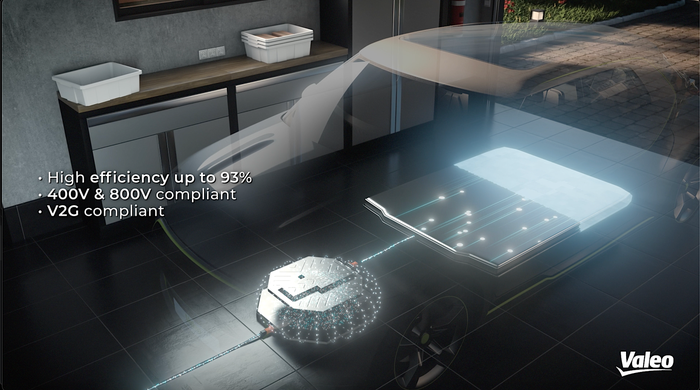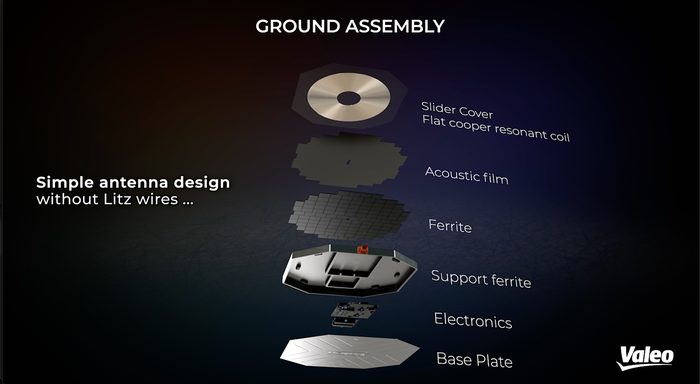Valeo Ineez Air Charging Promises Lighter, Cheaper Wireless EV Charging
There’s just one catch…
.gif?width=850&auto=webp&quality=95&format=jpg&disable=upscale)
At a Glance
- 50 percent lighter than current solutions.
- Connects to any existing wall box charger.
- Simpler control electronics.
French Tier 1 automotive supplier Valeo has introduced a new inductive wireless EV charging technology that promises to speed adoption thanks to lower cost and lighter weight of on-vehicle equipment. Valeo’s Ineez Air Charging wireless charging system weighs half as much as other products and maintains 93 percent efficiency from grid to battery.
Keep in mind when considering that 93 percent efficiency number that wired charging also falls short of 100 percent efficiency, at about 95 percent, so the delta between the two systems is minimal.

VALEO
But wait, there’s more… Valeo has 25 design patents on the system covering hardware, software, and mechatronics. These contribute to the wireless charging pad’s compatibility with every home charging wall box, every country’s grid (1 or 3-phase networks), and with all cars, whether they have 400-volt or 800-V batteries. It even works with Vehicle-to-Grid (V2G) systems to provide backup home power and grid load balancing for 7-kilowatt to 22-kW loads.
This power range points to the fact that Ineez Air Charging is a solution for SAE Level 2 AC charging stations and not as an alternative to DC fast chargers, which can provide as much as 350 kW of charging power.
Giving EV drivers the ability to recharge at home or work without needing to wrestle with a charging cord or spend the time connecting it will make EVs more attractive, said Jonathan Rost, Customer Chief Engineer Valeo Powertrain Systems, North America.

VALEO
Valeo sells corded charging stations today, but the company thinks that inductive wireless charging will be more popular with customers. “One of the biggest pain points of owning an electric vehicle is plugging it in,” said Rost. “This is a negative impact for a lot of customers,” he said. “Sometimes the connector is icy cold and stiff or dirty.”
Parking a car on top of an inductive charging pad eliminates those concerns. The cost of such systems has been an obstacle, but Valeo says that it lowers that hurdle in the Ineez Air Charging system by choosing a different technical solution than others use.

VALEO
This is where we get to the caveat. Ineez Air Charging works at 3 kilohertz, rather than the 85-kHz SAE J2954 industry standard. This means that cars equipped with inductive systems for one of these frequencies will not work with pads made for the other one. It would be as if Android phones wouldn’t charge on the same inductive pads as Apple phones.
Valeo says that the technical advantages will tilt carmakers in its favor as they consider installing inductive charging receivers on their cars. That’s because the low-frequency system works with thin solid copper wire inside rather than a heavy bundle of stranded wire, according to Rost. Also, the Ineez Air Charging system has simplified electronics compared to the 85-kHz devices, he said. “High-frequency forces use of expensive materials,” he said.

VALEO
The company showed a 7-kW device at CES 2024, but it is targeting 11 kW for a production device that could arrive in model year 2027, according to Rost. However, the technology can accommodate power of 22 kW for customers who need faster charging, and Valeo could ultimately offer 7 kW or even 3.5 kW systems for price-sensitive customers who have time for overnight charging. “We think 11 is the good value for home charging,” he noted.
Valeo envisions the Ineez devices being used where vehicles spend time, such as in home garages and offices. It is also a good solution for commercial fleets, where vehicles like buses and taxis could top off their batteries while stopped for a short time multiple times a day.
Autonomous vehicles like robo-taxis could really benefit when there is no supervising operator aboard to plug and unplug a charging cable during the course of the day. The question is which standard carmakers will choose, and Valeo is currently targeting OEMs to partner on introducing this technology to drivers.
About the Author(s)
You May Also Like





